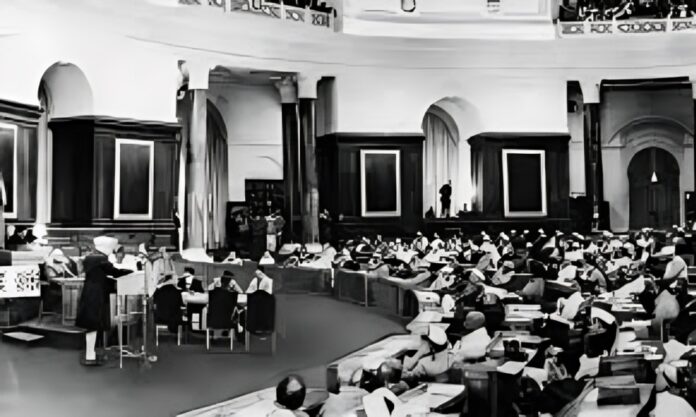By the end of July 1946, British India elected its Constituent Assembly, consisting of 296 members. The Congress had won all the general seats except nine whereas the Muslim League had won all the Muslim seats except five. On 9 December the first meeting of the Assembly was to be held. But Muslim League refused to recognize the Assembly as a valid body until the Congress would accept the Muslim League’s interpretation of the clause regarding the grouping of the provinces. At first the Viceroy tried to convince the Congress to accept the demand of the Muslim League but Gandhi and Nehru started urging the British Government for the removal of the Viceroy. As a result the Viceroy issued the invitations for the meeting of the Constituent Assembly on 20th November under the Cabinet Mission Plan.
Quaid-i-Azam was of the opinion that the Viceroy was trying to appease the Congress and did not realize the serious situation. Therefore no Muslim League representative would attend the meeting of the Assembly on 9th of December. Trying to find an agreement between the Congress and the Muslim League, the British Government invited two Congress leaders, two Muslim League leaders and a Sikh representative for having talks in London.
Meanwhile the Congress was getting more and more aggressive and demanding the removal of the Muslim League from the Government if it would not agree to participate in the Assembly. Nehru who was already adamant to claim at a press conference at Bombay that the Congress would enter the Constituent Assembly “completely unfettered by (any) agreement and free to meet all situations as they arose” alleged that there was an alliance between the British high officials and the members of Muslim League. But Liaquat Ali Khan protested against these allegations and clarified that the Muslim League had never asked the Viceroy for his intervention. Quaid-i-Azam pointed out that Nehru’s statement represented the real mind of the Congress. He argued that if the Congress could change so many times while the British were still in the country and power had not come to its hands, what assurance would the minorities have that once the British left, the Congress would not again change and go back to the position taken up in Jawaharlal’s statement. He further stated that the interim government was nothing but the Viceroy’s Executive Council reconstituted on the political lines. The League Councilors refused to recognize Nehru as the head of the Interim Government. Quaid-i-Azam said that Nehru was nothing but the Vice-President of the Council who presided only in the absence of the Viceroy and enjoyed no more powers. So it was quite misleading to call the Interim Government a ‘National Government’ or to characterize the Council as the ‘Cabinet’.
On 2nd December 1946, Quaid-i-Azam, Liaquat Ali Khan, Nehru and Baldev Singh arrived in London for the talks with the British Government. As usual the talks failed to reach an agreed solution and on 6th December the British Government issued a statement for resolving the controversy about the grouping clause by giving their own authoritative interpretation.
On 22nd December the Congress Working Committee reiterated that the interpretation of the British Government was not in conformity with the basic proposal of the Cabinet Mission plan. When the All India Congress Committee met on 5th January 1947 and rejected the official interpretation, the Muslim League Working Committee passed a resolution on 31st January that took the notice of the British interpretation because it was the same as presented by Muslim League. The Muslim League also condemned the rejection of the official interpretation by Congress.
Finally it was decided that the Assembly should be dissolved. There was no need of calling the Muslim League Council to reconsider its decision of July 1946. Moreover Sir Stafford Cripps declared in the House of Commons that if the Muslim League could not be persuaded to attend the Constituent Assembly, then those parts of the country where they were in the majority could not be held together by the results. It was tantamount to negate the idea of Pakistan. But later developments proved what he had said in May 1946 was wrong.
This article was last updated on Monday, Jan 01, 2007






